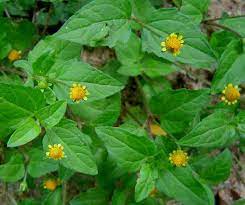swahili name
More Local Names
borana:
DIGO:
duruma:
giriama:
kamba:
Mutata
kauma:
kikuyu:
Gatharaita
kipsigis:
kisii:
kuria:
luhya:
LUO:
Ajuok-olaw
maasai:
Ekum
maragoli:
meru:
mijikenda:
nandi:
NUBI:
OGIEK:
pokomo:
pokot:
rabai:
sabaot:
samburu:
suba:
TURKANA:
Scientific Name
Spilanthes mauritiana
plant family
Plant Details and use
Botanical Overview
- Family: Asteraceae
- Growth Form:
Spilanthes mauritiana is a small, herbaceous annual or perennial that typically reaches a modest height. The plant is characterized by its fleshy, globular flower heads that are composed of numerous small, tubular florets. - Morphological Features:
- Leaves: Alternately arranged, simple, and green, often with a slightly aromatic quality.
- Flowers: The showy, globular flower heads are the most notable feature. When chewed, these flower parts release active compounds that produce a tingling, numbing sensation.
- Native Range and Habitat:
While native ranges can vary, Spilanthes species are generally widespread in tropical and subtropical regions. They thrive in disturbed areas, along roadsides, and in home gardens where they are often cultivated for both culinary and medicinal purposes.
Traditional Uses and Health Conditions Addressed
Spilanthes mauritiana is primarily known for its powerful analgesic and anti-inflammatory properties. The most well-documented traditional use is in the relief of dental pain, which has led to its common name, the "toothache plant." Additional traditional applications include:
- Toothache and Gum Inflammation:
The active compounds in the flower heads produce a numbing sensation, offering temporary relief from toothache and sore gums. - Oral Infections and Sore Throat:
The antimicrobial properties of the plant make it useful for reducing minor oral infections and soothing a sore throat. - Anti-inflammatory and Analgesic Uses:
Beyond oral applications, preparations of Spilanthes mauritiana are sometimes used to treat localized pain and inflammation in other parts of the body.
Traditional Preparation and Use
1. Direct Chewing for Dental Pain Relief
Preparation and Use:
- Collection: Fresh flower heads are carefully plucked from the plant.
- Application: The individual chews on one or more flower heads slowly. Chewing releases the natural oils and active compounds (such as spilanthol) responsible for the tingling, numbing effect.
- Effect: The numbing sensation provides temporary relief from toothache and soothes inflamed gums.
2. Decoction for Oral and Systemic Use
Preparation:
- Harvesting and Cleaning: Gather fresh or shade-dried flower heads (and sometimes leaves) and rinse them thoroughly with clean water.
- Boiling: Place approximately 1–2 teaspoons (or a predetermined amount based on local tradition) of the plant material into a small pot with about 250–300 mL of water.
- Simmering: Bring the mixture to a boil, then lower the heat and allow it to simmer for about 10–15 minutes to extract the active ingredients.
- Straining: Allow the decoction to cool slightly, then strain to remove solid plant material.
Traditional Usage:
- Oral Rinse: The decoction can be used as a mouth rinse to help reduce oral infections and soothe a sore throat.
- Internal Consumption: Some traditions advocate a small dose (one cup taken once or twice daily) to harness its anti-inflammatory and general tonic effects.
3. Topical Paste for External Application
Preparation:
- Fresh Paste: Fresh flower heads are pounded using a mortar and pestle until a smooth, consistent paste is obtained. A few drops of water may be added to adjust the consistency.
- Application: This paste is applied directly to areas of localized pain or inflammation, such as on the gums (for toothache) or on minor skin abrasions.
Uses:
- Wound Healing: It can be used as a poultice on small cuts or bruises.
- Local Analgesic: When applied to inflamed areas, the paste helps to reduce pain and inflammation due to its active anti-inflammatory constituents.
Health Conditions Tackled
Through these traditional preparations, Spilanthes mauritiana is used to address several health conditions, including:
- Dental Pain: Direct chewing of the flower heads is the most common and effective use for alleviating toothache.
- Gum and Oral Inflammation: Both direct chewing and topical pastes help reduce swelling and soreness in the gums.
- Minor Oral Infections & Sore Throat: Using a decoction as an oral rinse can help tackle microbial infections in the mouth and throat.
- General Anti-inflammatory and Analgesic Effects: The plant's compounds help in reducing localized pain and inflammation in various applications.
Safety and Considerations
- Dosage and Monitoring: Traditional methods rely on experienced healers who adjust dosages based on the condition and individual patient sensitivity.
- Potential Irritation: Although the numbing effect is beneficial, overuse or improper preparation can sometimes lead to irritation.
- Integration with Modern Medicine: For sustained or severe conditions, traditional use is often complemented with modern dental care.
treatable conditions
Did you find this helpful?
people found this page useful.
